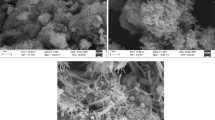Abstract
The degradation of cellulose (a substantial component of low- and intermediate-level radioactive waste) under alkaline conditions occurs via two main processes: a peeling-off reaction and a basecatalyzed cleavage of glycosidic bonds (hydrolysis). Both processes show pseudo-first-order kinetics. At ambient temperature, the peeling-off process is the dominant degradation mechanism, resulting in the formation of mainly isosaccharinic acid. The degradation depends strongly on the degree of polymerization (DP) and on the number of reducing end groups present in cellulose. Beyond pH 12.5, the OH- concentration has only a minor effect on the degradation rate. It was estimated that under repository conditions (alkaline environment, pH 13.3-12.5) about 10% of the cellulosic materials (average DP = 1000-2000) will degrade in the first stage (up to 105 years) by the peeling-off reaction and will cause an ingrowth of isosaccharinic acid in the interstitial cement pore water. In the second stage (105-106 years), alkaline hydrolysis will control the further degradation of the cellulose. The potential role of microorganisms in the degradation of cellulose under alkaline conditions could not be evaluated. Proper assessment of the effect of cellulose degradation on the mobilization of radionuclides basically requires knowing the concentration of isosaccharinic acid in the pore water. This concentration, however, depends on several factors such as the stability of ISA under alkaline conditions, sorption of ISA on cement, formation of sparingly soluble ISA-salts, etc. A discussion of all the relevant processes involved, however, is far beyond the scope of the presented overview.
Similar content being viewed by others
References
NAGRA (1994)Endlager für schwach- und mittelaktive AbfÄlle (Endlager SMA). Bericht zur Langzeitsicherheit des Endlagers SMA am Standort Wellenberg (Gemeinde Wolfenschiessen, NW), NAGRA Technical Report NTB 94-06, NAGRA, Wettingen, Switzerland.
U. Berner (1990)A Thermodynamic Description of the Evolution of Pore Water Chemistry and Uranium Speciation During the Degradation of Cement, PSI-Bericht 62, Paul Scherrer Institute, Villigen, Switzerland. (Also published as NAGRA Technical Report NTB 90-12, NAGRA, Wettingen, Switzerland)
R. L. Whistler and J. N. BeMiller (1958)Adv. Carbohydr. Chem. Biochem. 13, 289–329.
M. J. Blears, G. Machell, and G. N. Richards (1957)Chem. Ind. Aug. 24, 1150-1151.
G. Machell and G. N. Richards (1960)J. Chem. Soc. A 2, 1932–1939.
D. T. Sawyer (1964)Chem. Rev. 64, 633–643.
A. D. Moreton (1993)Mater. Res. Soc. Symp. Proc. 294, 753–758.
B. F. Greenfield, G. F. Holtom, M. H. Hurdus, N. O’Kelly, N. J. Pilkington, A. Rosevaer, M. W. Spindler, and S. J. Williams (1995)Mater. Res. Soc. Symp. Proc. 353, 1151–1158.
M. H. Bradbury and F. A. Sarott (1995)Sorption Databases for the Cementitious Near-Field of a L/ILW Repository for Performance Assessment, PSI-Bericht 95-06, Paul Scherrer Institute, Villigen, Switzerland. (Also published as NAGRA Technical Report NTB 93-08, NAGRA, Wettingen, Switzerland.)
K. Okamura (1991) in D. N.-S. Hon and N. Shiraishi (Eds.),Wood and Cellulosic Chemistry, Marcel Dekker, New York and Basel, pp. 89–112.
H. Krassig (1985) in J. F. Kennedy, G. O. Phillips, D. J. Wedlock, and P. A. Williams (Eds.),Cellulose and Its Derivatives: Chemistry, Biochemistry and Applications, Marcel Dekker, New York, Chichester, Brisbane, pp. 3–25.
D. W. Haas, B. F. Hrutfiord, and K. V. Sarkanen (1967)J. Appl. Polym. Sci. 11, 587–600.
M. Lewin (1985) in J. F. Kennedy, G. O. Phillips, D. J. Wedlock, and P. A. Williams (Eds.),Cellulose and Its Derivatives: Chemistry, Biochemistry and Applications, Marcel Dekker, New York, Chichester, Brisbane, pp. 27–35.
F. Neall (1994)Modelling of the Near-Field Chemistry of the SMA Repository at the Wellenberg Site, PSI-Bericht 94-18, Paul Scherrer Institute, Villigen, Switzerland.
E. Sjöström (1977)TAPPI 60, 151–154.
Y. Z. Lai (1991) in D. N.-S. Hon and N. Shiraishi (Eds.),Wood and Cellulosic Chemistry, Marcel Dekker, New York and Basel, pp. 455–523.
A. R. Procter and R. H. Wiekenkamp (1969)Carbohydr. Res. 10, 459–462.
A. R. Procter and H. M. Apelt (1969)TAPPI 52, 1518–1522.
J. R. G. Bryce (1980) in J. P. Casey (Ed.),Pulp and Paper, Chemistry and Chemical Technology, Vol. 1, 3rd ed., John Wiley & Sons, New York, pp. 429–436.
V. L. Chiang and K. V. Sarkanen (1984)J. Wood Chem. Technol. 4, 1–18.
J. C. Miller and J. N. Miller (1988)Statistics for Analytical Chemistry, Ellis Horwood, Chichester.
Y. Z. Lai and K. V. Sarkanen (1969)J. Polym. Sci.C 28, 15–26.
R. A. Young, K. V. Sarkanen, P. G. Johnson, and G. G. Allan (1972)Carbohydr. Res. 21, 111–122.
G. Machell and G. N. Richards (1958)TAPPI 41, 12–16.
Y. Z. Lai and D. E. Ontto (1979)J. Appl. Polym. Sci. 23, 3219–3225.
T. Vuorinen and E. Sjöström (1982)Carbohydr. Res. 108, 23–29.
R. L. Colbran and G. F. Davidson (1961)J. Textile Inst. 52, T73-T87.
Y. Z. Lai and K. V. Sarkanen (1967)Cellulose Chem. Technol. 1, 517–527.
Y. Z. Lai (1981)The Eckman Days, Vol. 2. International Symposium on Wood and Pulping Chemistry, Stockholm, June 9-12, pp. 26–33.
O. Franzon and O. Samuelson (1957)Svensk Papperstidning 23, 872–877.
Y. Z. Lai (1972)Carbohydr. Res. 24, 57–65.
N. Morohoshi (1991) in D. N.-S. Hon and N. Shiraishi (Eds.),Wood and Cellulosic Chemistry, Marcel Dekker, New York and Basel, pp. 331–392.
D. A. I. Goring and T. E. Timell (1962)TAPPI 45, 454–460.
L. R. Van Loon and M. A. Glaus (1997) in preparation.
M. H. Bradbury and L. R. Van Loon (1997)Cementitious Near-Field Sorption Databases for Performance Assessment of a L/ILW Repository in a Palfris Marl Host Rock, PSI-Bericht (in preparation), Paul Scherrer Institute, Villigen, Switzerland. (Also published as NAGRA Technical Report NTB 96-04, NAGRA, Wettingen, Switzerland.)
Author information
Authors and Affiliations
Rights and permissions
About this article
Cite this article
Van Loon, L.R., Glaus, M.A. Review of the kinetics of alkaline degradation of cellulose in view of its relevance for safety assessment of radioactive waste repositories. J Environ Polym Degr 5, 97–109 (1997). https://doi.org/10.1007/BF02763593
Issue Date:
DOI: https://doi.org/10.1007/BF02763593




